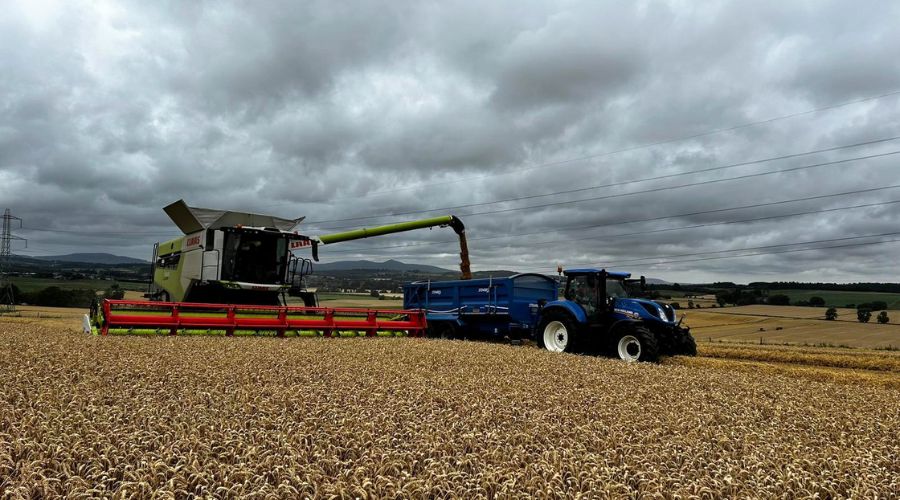Bamford crop wins best wheat in RNAS cereal growing competition
21st September 2024
High-yielding soft wheat has overcome torrential rain and high septoria disease pressure to secure the top award.

A first-time crop of Bamford grown by Aberdeenshire farmer Scott Campbell of Kirkton, Kinellar has won best winter wheat and was judged to be the overall reserve champion in a cereal growing competition organised by the Royal Northern Agricultural Society.
The annual competition, open to farmers in the North East of Scotland and sponsored by seed merchant McCreath Simpson and Prentice, has been attracting entries from Elgin in the North to Stracathro in the South, with judging taking place in July.
Winning farmer Scott Campbell said that he is “delighted” with the result.
He added: “It’s a high-level competition and, having been on the judging panel myself in the past, I can confirm that the overall agronomic standard of entries is extremely high.
“Our 12ha Bamford crop was drilled as a first wheat on 20th September at a seed rate of 400 seeds m2, initially establishing well until we were hit by persistent heavy rain from mid-October.
“Things then went from bad to worse with further unprecedented wet weather that continued from Christmas right through till early Spring, delaying both our first 2 scheduled splits of nitrogen (N) and our T0 fungicide spray.
“During this key period, our only piece of luck was managing to avoid heavy frosts, which would have knocked the crop back even further.”
Much-needed flexibility
Mr Campbell said that the delayed first application of granular N was eventually applied on 1st March, with a further application of potash following a month later. A second split, this time liquid N at 300l/ha, was then delayed until 12th April.
“Through March and April, we were understandably concerned about the missed timings and our inability to get the sprayer onto certain sections of the fields with standing water still visible in places.
“The T0 was finally applied on 20th April, with our T1 following on 12th May. By the time we’d applied the main flag leaf spray on 1st June, the wet weather had finally abated and we’d just about caught up.
“Thankfully, Bamford’s robustness was able to offer us some much-needed flexibility on the key fungicide sprays in a year where septoria pressure was also extremely high,” the farmer continued.
Challenging season
Mr Campbell added that by 24th June, when he applied the T3, the crop was still showing three clean leaves.
He said: “During a very challenging season, I’d certainly say it lived up to its 6.7 septoria rating, not requiring the extra spray that we’d have considered for many other varieties in similar circumstances.
“Cutting on 1st September at 19.5% moisture, higher than ideal but compromised by an early dry weather window, Bamford yielded 10t/ha – just below our five-year average of 10.2t/ha with a specific weight of 80.9kg/hl.
“In the context of the unprecedented weather we received between October and April that was an incredible performance, fully justifying my faith in our agronomist Charlie Catto who’d recommended the new Group 3 winter wheat to us.”
The Aberdeenshire farmer concluded that on the basis of its year one performance he will be increasing the drilled area of Bamford to 40ha this autumn with an eye on distilling as our end market.
Proved resilience
Agrii agronomist Charlie Catto, who has worked with Mr Campbell for a number of years, said: “In a very high septoria disease pressure year for the North East of Scotland, combined with a meter of rain which fell between mid-October and April, I don’t think we could have picked a tougher season for Scott’s first crop of Bamford.

“However, it has certainly proved its resilience and seems very well suited to growing conditions in the North. As a soft wheat, with multiple end market options, there’s little doubt in my mind that Scottish growers need a more flexible variety like Bamford.
“Although it’s still early days, I think there’s definite potential for Bamford to establish itself as a game-changing variety, such as Riband in the 1990’s or, more recently, Skyscraper during the last 10 years.
“In Bamford and Blackstone, breeder Elsoms Seeds has two very exciting winter wheats with the right credentials to secure a good percentage of the Scottish soft wheat market.”
Read more arable news.



